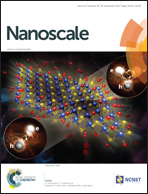Selective protein trapping within hybrid nanowells†
Abstract
Nanostructured surfaces offer a great deal in view of the control of biological processes at subcellular level. An innovative methodology has been developed to fabricate large-scale hexagonally close-packed arrays of polymer/gold nanowells of tunable diameter and depth, ranging between about 70 and 100 nm (diameter) and 15 and 40 nm (depth). Nanowell volumes down to 0.3 attolitres and nanowell densities as high as ∼109 wells per cm2 could also be demonstrated. The present paper investigates the main features of protein trapping processes within the obtained nanowell arrays. Selective protein trapping, also involving orientation and biofunctionality changes, appears to be induced by the nanoconfinement. Nanomorphology measurements and antibody preferential linkages are demonstrated for human serum albumin versus lysozyme, the first being efficiently trapped within the nanocavities and the second being preferentially deposited outside them. The selective protein-dependent trapping/untrapping within the nanowells is discussed in terms of the variation in the out-diffusion coefficients of the biomolecules entering the nanowells, either as a function of the matching/mismatching of the biomolecules and nanocavity dimensions, or, alternatively, owing to the drastic conformational changes due to nanoconfinement. In this case, the trapping of large and soft human serum albumin is privileged with respect to the small and hard lysozyme. Furthermore, the observed peculiar antibody response to the confined proteins is accounted for in terms of the enhancement of their biological response following the modified accessibility of the key epitopes, which in turn suggests drastic conformational changes.


 Please wait while we load your content...
Please wait while we load your content...